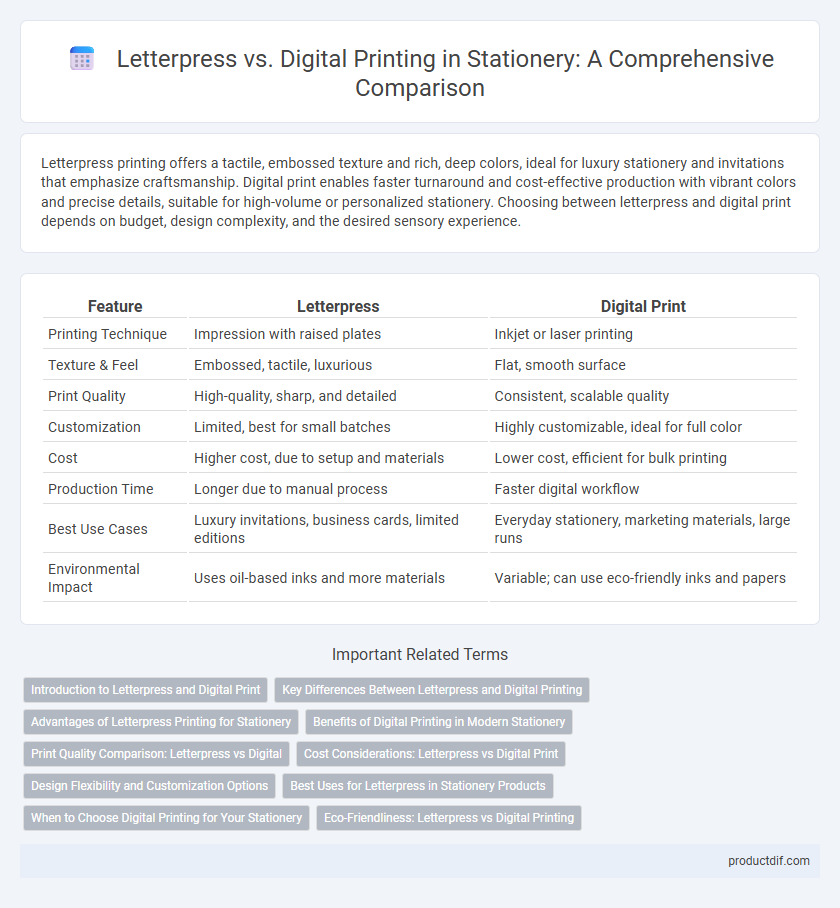Letterpress printing offers a tactile, embossed texture and rich, deep colors, ideal for luxury stationery and invitations that emphasize craftsmanship. Digital print enables faster turnaround and cost-effective production with vibrant colors and precise details, suitable for high-volume or personalized stationery. Choosing between letterpress and digital print depends on budget, design complexity, and the desired sensory experience.
Table of Comparison
| Feature | Letterpress | Digital Print |
|---|---|---|
| Printing Technique | Impression with raised plates | Inkjet or laser printing |
| Texture & Feel | Embossed, tactile, luxurious | Flat, smooth surface |
| Print Quality | High-quality, sharp, and detailed | Consistent, scalable quality |
| Customization | Limited, best for small batches | Highly customizable, ideal for full color |
| Cost | Higher cost, due to setup and materials | Lower cost, efficient for bulk printing |
| Production Time | Longer due to manual process | Faster digital workflow |
| Best Use Cases | Luxury invitations, business cards, limited editions | Everyday stationery, marketing materials, large runs |
| Environmental Impact | Uses oil-based inks and more materials | Variable; can use eco-friendly inks and papers |
Introduction to Letterpress and Digital Print
Letterpress printing uses a traditional relief technique where ink is pressed onto paper, creating a tactile and embossed effect that adds depth and elegance to stationery. Digital printing involves using digital files to directly transfer images onto paper, offering faster turnaround times and the ability to easily customize each piece. Letterpress is ideal for premium, textured designs, while digital printing excels in cost-effective, high-volume production with vibrant color accuracy.
Key Differences Between Letterpress and Digital Printing
Letterpress printing uses a relief technique that presses inked plates onto paper, producing deep impressions with tactile texture, while digital printing relies on laser or inkjet methods to transfer images directly onto the surface without embossing. Letterpress excels in traditional, artisanal quality with limited color options, whereas digital printing offers rapid turnaround, cost-effective production, and vibrant, full-color capabilities. The choice depends on desired aesthetic, volume requirements, and budget constraints in stationery projects.
Advantages of Letterpress Printing for Stationery
Letterpress printing offers unmatched tactile quality and depth, creating a distinctive impression that elevates stationery with a luxurious, handcrafted feel. Its ability to use thick, textured paper enhances durability and sophistication, making invitations, business cards, and personalized notes stand out. Letterpress's artisanal process ensures each piece is unique, appealing to clients seeking bespoke stationery with a timeless, elegant aesthetic.
Benefits of Digital Printing in Modern Stationery
Digital printing offers rapid turnaround times and cost-effective short runs, making it ideal for customized stationery projects. The technology enables vibrant, high-resolution color reproduction and intricate designs that enhance brand identity. Variable data printing allows personalized stationery with unique names or addresses, improving customer engagement and professional appeal.
Print Quality Comparison: Letterpress vs Digital
Letterpress printing delivers a tactile, embossed texture with rich, deep ink saturation, creating a distinct, high-quality finish ideal for luxury stationery and invitations. Digital printing offers precise color accuracy and faster turnaround, excelling in detailed images and gradients but lacks the physical depth and texture of letterpress. For premium print quality emphasizing craftsmanship, letterpress remains unmatched, while digital print provides versatility and consistent color reproduction.
Cost Considerations: Letterpress vs Digital Print
Letterpress printing typically involves higher upfront costs due to the creation of custom plates and the manual labor required, making it more suitable for larger print runs to offset expenses. Digital print offers lower initial costs and greater flexibility, ideal for small batches or personalized stationery without the need for setup fees. Businesses must evaluate print volume and budget constraints when choosing between the premium tactile quality of letterpress and the cost-effective convenience of digital printing.
Design Flexibility and Customization Options
Letterpress printing offers tactile depth and rich texture, ideal for luxurious stationery with limited color palettes and design elements. Digital print provides unmatched design flexibility, supporting vibrant full-color images, intricate details, and rapid customization for personalized stationery. Choosing between letterpress and digital print depends on balancing the desire for classic craftsmanship against the need for versatile, detailed designs.
Best Uses for Letterpress in Stationery Products
Letterpress excels in producing high-quality wedding invitations, business cards, and personalized stationery due to its tactile, embossed texture that adds elegance and sophistication. It is ideal for small print runs where craftsmanship and detail are prioritized over speed and cost-effectiveness. The technique enhances the visual appeal of luxury stationery by creating deep impressions and rich ink coverage that digital print cannot replicate.
When to Choose Digital Printing for Your Stationery
Digital printing is ideal for short-run stationery projects that require quick turnaround times and cost-effective production. It offers precise color matching and customization options, perfect for personalized invitations, business cards, or promotional materials. When flexibility, speed, and lower setup costs are priorities, digital printing outperforms traditional letterpress methods.
Eco-Friendliness: Letterpress vs Digital Printing
Letterpress printing uses traditional methods with durable metal type and plant-based inks, creating minimal waste and allowing impressions on recycled paper, making it highly eco-friendly. Digital printing reduces paper waste through precise ink application and utilizes soy or water-based inks, often supporting recycled paper options while consuming less energy. Both methods offer sustainable advantages, with letterpress emphasizing minimal chemical use and tangible reuse, and digital printing excelling in resource efficiency and waste reduction.
Letterpress vs Digital Print Infographic

 productdif.com
productdif.com